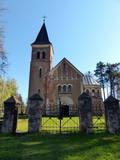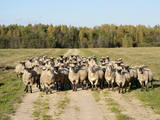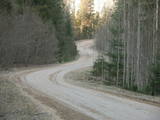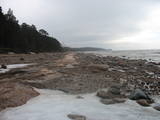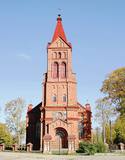| Нo | Название | Описание |
|---|---|---|
|
Установлен напротив Крустпилсского замка, на улице Ригас. Памятник, построенный в 1925 году и восстановленный в 1992 году (автор A. Бирзниекс), установлен в честь павших крустспилсчан в боях за свободу Латвии. Отсюда приоткрывается вид на Маленькую Даугаву, Даугавсалиню и островок Адамсона (Крустспилс). |
||
|
В хозяйстве Epi на острове Сааремаа производят фруктовые и ягодные кетчупы, различные виды варенья, выращивают пряности и чаи. При изготовлении продуктов используется только местное ‒ выращенное на островах Сааремаа и Муху ‒ сырье. Продукты можно купить напрямую из хозяйства. |
||
|
Atrodas 0,3 km ziemeļos no Vecpiebalgas pilsdrupām. Ap 10 m augsto, bet visnotaļ izteiksmīgo Grišku kalnu sauc arī par Piebalgas, Balgas un Veļķu pilskalnu. 13. gs. šeit bijusi svarīga apmetnes vieta ar mākslīgi nostāvinātām nogāzēm un dziļu aizsarggrāvi. Vēstures notikumi ir atstājuši ap metru biezu kultūrslāni. Bezlapu laikā no kalna paveras skats uz Vecpiebalgas baznīcu un pilsdrupu vietu. Pilskalna piekājē ir aka ar Griškavotu. |
||
|
Теперешнюю, третью по счету церковь, построили в 1906 году по инициативе и выделенному финансированию Готтхарда фон Будберга. Храм строился в честь его умершей жены Гертруды Ворс. В церкви установлен орган фирмы Walker, который в 1906 г. был построен в Людвигсбурге (Южная Германия). В 1992 году здесь открыта мемориальная доска памяти репрессированных жителей Гарсене. В 100 м к востоку от церкви, на кладбище стоит окутанный легендами фамильный склеп баронов Будбергов.Здесь же находится родовое кладбище баронов.Церковь можно осмотреть изнутри. |
||
|
This reserve was set up to protect local swamps and surrounding wetlands. Please note that before you can visit the reserve, you must register with the local administration and visitor centre in the village of Tooma.
|
||
|
Regīna Kalniņa is one of the best known craftswomen in Kurzeme. She weaves blankets and shawls and knits colourful mittens. She also sews Rucava and Nīca folk costumes. The process of weaving and knitting can be viewed. Regīna’s products are widely demanded in Latvia and in other European countries. |
||
|
История епископского замка Вастселийна уходит корнями в 14 век, до 17 века замок служил мощной пограничной крепостью между Россией и Европой. Крепость была разрушена во время Северной войны в 1702 году. В средние века епископский замок был одним из мест паломничества в католическом мире. |
||
|
На полях хозяйства (разместилось в доме прислуги бывшей господской усадьбы «Кемпену») пасется более 200 голов Латвийской темноголовой овцы. Здесь можно приобрести мясо, шерсть, кожу и принять участие в познавательной экскурсии с дегустацией, ловить рыбу и дегустировать форель (рыба только для клиентов, которые остаются на ночлег). |
||
|
This structure is smaller than the Great Kangari hills – approximately 10 kilometres long and 16 metres high. This structure is near the Buļļi swamp, and the restricted area is meant to protect the structure, the swamp and the various forest types and rare plants that are in the area.
|
||
|
Замечательное место для семьи, детей и всех интересующихся, где можно отправиться на экскурсию или самим посмотреть и узнать больше о сурках. |
||
|
The trail tells about grey dunes which have survived thanks to the border restrictions and the presence of military. The trail starts from the parking place at the mouth of the Užava river. It is one of the few natural rivermouths in Europe. One can also see the „tacis”, an industrial installation for lamprey (Lampetra fluviatilis) fishing during their spawning migration period. The 3km long trail is circular. It winds for 1.5km from the Užava rivermouth to the North, along the coastline (the beach is covered with sand and pebbles), and returns to the starting point by a gravel road through grey dunes. Along the trail, one can observe a distinct white dune with rare plant species Linaria loeselii, Lathyrus maritimus, Anthyllis arenaria, Tragopogon heterospermus. About 1km from the rivermouth, in the sea, one can see a wrack of a sailing ship (parts of frame). The visibility depends on the flow of sand in the sea. The way back opens a beautiful view of the range of grey dunes. Unfortunately, Scots Pine starts taking over the area. There are three important biotopes of EU significance: „Fixed dunes with herbaceous vegetation 2130”, „Decalcified fixed dunes with Empetrum nigrum 2140” and „Dunes with Salix arenaria 2170”, forming a unique mosaic. Typical species here: mountain Alison ‘(Alyssum gmelinii), Pasqueflower (Pulsatilla pratensis), Sand Pink (Dianthus arenarius), Rosemary Leaved Willow (Salix rosmarinifolia), Dark Red Helleborine (Epipactis atrorubens), Kinnikinnick (Arctostaphylus uva-ursi). As a former military site, some military constructions can be seen here like horseshoe-shaped sand ramparts by the road in gray dunes. They were built to disguise military vehicles in case of sea attack. By the Kangroti graveyard, towards the Užava river, there is an underground pillbox. It is a one-man fortification to fire along the coastal perimeter. The Mouth of River Užava walking route is in the nature reserve „Užava” |
||
|
Одни из редко встречающихся берестоплетельщиков в Латвии предлагают осмотреть мастерскую, увидеть изготовленные из бересты предметы и делятся опытом. Каждый интересующийся при помощи мастеров может изготовить из бересты простые предметы, которые подойдут в качестве замечательных сувениров. |
||
|
The Neļķes cliffs are in Skaņākalns Park, and they offer the most beautiful view of the Salaka River valley, with its sandstone cliffs and peaceful river. There are good views from the “devil’s pulpit.” It’s worth visiting the Skaņamkalns Hill to check out the views from the famous echo cliff. This is part of the ZBR.
|
||
|
Since ancient times bread has been our staple food, and formed part of breakfast, lunch and our evening meal. We bake bread from rye, wheat, buckwheat and barley. Both fine-ground and wholemeal flour is used. Bread baking is one of the most honoured traditional skills in Latvia. Caunītes country house keeps Latvian traditions alive and demonstrates them to visitors. The house is designed and decorated in the traditional Latvian style and exudes an authentic ambience while having modern facilities. Under the guidance of the hostess, visitors will bake their own loaf of sweet-and-sour bread in a wood-fired bread oven. In Latvian families it was traditionally one of the main duties of the lady of the house to bake a week’s supply of bread for the whole family every Saturday morning. Every woman was proud of her own unique recipe and passed it down to her daughters and granddaughters through the generations. There are many traditional beliefs, sayings and riddles linked with bread in Latvian folklore. Today, there is great interest in the old recipes, bread-baking methods and the use of organic ingredients as many families are opting for a healthy lifestyle. |
||
|
Одно из редких предложений в Латгалии, где во время туристической экскурсии гид поет на латгальском языке. Интересный, аттрактивный и познавательный рассказ об исторических событиях, связанных с Прейльской господской усадьбой и городской средой. |
||
|
Селга к западу от Туи – важная территория для защиты малой чайки в период весенней миграции. Территория расположена напротив Салацгривского, Лимбажского, Саулкрастского и Царникавского края, ее площадь составляет 58 600 га.
|
||
|
В садах хозяйства выращивают яблоки, груши и лечебные растения (мяту, ноготки и др.). Собирают и дикорастущие лечебные растения. Проведут интересную экскурсию. Продукцию можно купить на месте или приобрести в магазине латвийских эко-продуктов на улице Барона 45 – 47, в Риге. |
||
|
Цискадский Римско-католический костёл Св. Иоанна Крес-тителя
построен в романском стиле в 1900 году из камня и красного кирпича. В
костёле находятся картина „Мадонна с младенцем”, распятие и орган.
|
||
|
Примерно в часе езды от Риги ‒ на территории старинной усадьбы Анны ‒ находится получивший международное признание дизайн-отель Annas Hotel. Вдохновленный старинными традициями латышской кухни шеф-повар ежедневно создает новое меню, позволяющее попробовать особые и непривычные блюда. Латышская кухня: Бульон с лисичками, блюда из крольчатины. Особое блюдо: Суп с черничным бальзамом и с творожным мороженым. |
||
|
Divarpus kilometrus gara taka (vienā virzienā) aizved līdz Hallistes palieņu pļavām, kur Hallistes upes labajā krastā ir uzcelts divstāvīgs koka skatu tornis. No tā paveras visaptverošs skats uz atjaunotajām (izcirsti krūmi) Hallistes palieņu pļavām. Pavasara palu laikā no torņa redzamā apkārtne un tornis atrodas ūdenī. |
||




